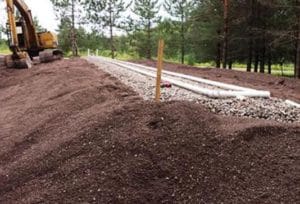Q: We are replacing a house on Maryland’s Eastern Shore. The house has a 5-year-old BAT system with a sand mound that has been maintained by the state. We just received notice the other day that we didn’t have enough acreage for a second sand mound and would need to go a holding tank if the system failed. How worried should we be? Would there be alternatives? Is it possible to reuse the same location for a new mound? — Willa
A: The notice you received is certainly cause for concern. Eventually, all septic systems fail and need to be replaced. When yours fails at some point in the future, you may have limited options. Maryland has some of the strictest (and most confusing) septic system regulations in the country. Also local regulations at the town or county level can be more strict, but not less, than the state regulations.
Figuring out, exactly, what rules apply to your house will take some effort and possibly the help of a lawyer and licensed septic system designer. You say that you are “replacing a house.” Does that mean that you are tearing down the existing house and building a new one? Are you changing the footprint and/or number of bedrooms?

Any one of these conditions could affect the status of your septic system approval and options. For example, you may lose grandfathered septic system rights if this is considered a new build. You may be able to retain those rights by getting the project reclassified as a remodel by reusing a certain percentage of the original structure.
Taken at face value, when your system fails, your only option will be a holding tank that will need very frequent pumping – like living in a motor home. This will costly and unpleasant and will reduce your property value significantly.
In order of priority, I would suggest the following:
• Make every effort to extend the lifespan of your current system. That means regular pumping and other maintenance, reduced water usage (through low-flow fixtures and other water conservation efforts), and careful attention to what you put into the system – basically sewage, gray water, and nothing else. No garbage disposals, no bleach or antibacterial soaps, and no harsh household chemicals. Spread out any heavy water uses such as laundry loads.
• Get a full explanation of why a replacement mound is not permitted and under what conditions a replacement field might be allowed. Was the existing system properly permitted? Was it designed with a replacement drain field? What about replacing the mound in the same location as the existing mound. This is usually possible from an engineering standpoint, but messy and expensive. Basically, you need to excavate and remove the entire drain field, plus some of the surrounding soil. This needs to be hauled away and disposed of as hazardous waste, and then replaced with properly engineered and compacted fill.
• If you do not get satisfactory answers, you may need to contact a lawyer with extensive experience in septic system permitting. There may be legal work-arounds, zoning variances, grandfathering rules, or other regulatory wrinkles that could be employed to your benefit.
• If all else fails, you may need to consider alternative technologies such as waterless toilets. If you only need to dispose of graywater, you may find the regulations more forgiving.
The goal of Maryland’s BAT (Best Available Technology) program is to reduce the amount of nitrogen from septic systems that enters Chesapeake Bay and other sensitive coastal areas.
A lot of technologies have been approved by the state for reducing the nitrogen load, and financial assistance is provided to homeowners in some cases. I would think that one of these systems would be suitable for your lot. However, getting it approved by the local and state authorities will be an uphill battle. You can read more here about Maryland’s BAT program. — Steve Bliss, BuildingAdvisor.com
See Also:
Are Alternative Systems Allowed?
Chamber System Failure
How Much Slope For Septic Line?
Inspecting a Septic System
Lifespan of Septic System’
Minimum Lot Size For Septic System
Perc Test Cost
Perc Test: Best Time of Year?
Replacing Failed Drain Field in Same Location
Retesting a Site That Failed to Perc
Sand Filter for Existing System
Testing an Existing Septic System
Testing for a New Septic System
Wet Sites, Septic Systems For
Who Performs Perc Test?
View all SEPTIC SYSTEM articles
Leave a Reply